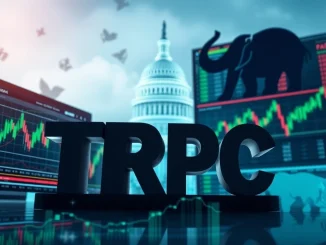
The cryptocurrency world is no stranger to dramatic shifts, but few stories capture the inherent volatility and evolving landscape quite like the recent announcement from Asymmetric Financial. For anyone following Solana News Today, the news of a prominent crypto hedge fund pivoting its entire strategy after a devastating fund decline is a stark reminder of the risks and rewards in this space. Asymmetric Financial, once known for its aggressive liquid trading strategies, is now charting a new course, moving decisively into the realm of illiquid blockchain infrastructure investments.
Asymmetric Financial: A Hard Reset After Public Scrutiny
The spotlight recently turned on Asymmetric Financial after a significant underperformance in its Liquid Alpha Fund became public. The catalyst was investor BigbrainSOL, who openly shared a $10 million loss on X, revealing a shocking 78.37% portfolio decline. This plunge, from an initial $12.89 million to a mere $2.78 million in the first half of the year, triggered widespread concern and criticism within the crypto community. CEO Joe McCann, in a candid public response, acknowledged the fund’s struggles, admitting it “is no longer serving our LPs.” This frank admission paved the way for the firm’s strategic pivot.
This isn’t just a minor adjustment; it’s a complete overhaul for a firm that previously thrived on high-risk, leveraged positions in the notoriously volatile crypto markets. The decision reflects a growing trend among institutional players to recalibrate their risk profiles amidst increasing regulatory scrutiny and a shifting investor preference towards projects with durable utility rather than speculative gains.
The Liquid Alpha Fund’s “Farm Strategy” and Its Fallout
What led to the dramatic decline of the Liquid Alpha Fund? McCann attributed the losses primarily to a “farm strategy” tied to the Hyperliquid airdrop. He optimistically claimed this strategy held the potential for “extraordinary returns” once the airdrop went live. However, critics were quick to highlight the inherent dangers of such highly leveraged exposure, especially in a market prone to rapid and unpredictable swings.
Key contributors to the fund’s collapse included several high-profile positions that imploded, notably a controversial Solana-related initiative. While the specifics of this initiative remain somewhat veiled, its failure underscores the perilous nature of concentrated, leveraged bets in niche crypto projects. The firm’s prior strategy, which centered on the rapid trading of volatile tokens, proved unsustainable during market downturns, with margin calls and forced liquidations accelerating price declines and exacerbating losses.
This situation serves as a powerful case study for investors:
- The Allure of Airdrops: While airdrops can offer significant upside, strategies heavily reliant on them, especially with leverage, carry immense risk.
- Leverage Amplifies Everything: In bull markets, leverage can magnify gains. In bear markets or during sharp corrections, it equally magnifies losses, leading to rapid capital erosion.
- Concentration Risk: Betting big on a few high-risk initiatives, even seemingly promising ones like certain Solana-related projects, can lead to catastrophic outcomes if they fail.
What Does This Mean for Solana News Today and Beyond?
While the direct impact on Solana’s underlying technology or ecosystem is minimal, the mention of a “controversial Solana-related initiative” contributing to Asymmetric’s downfall adds another layer to the ongoing narrative around the network. It highlights that even projects built on robust blockchains like Solana are not immune to poor investment strategies or market volatility. For those tracking Solana News Today, this serves as a reminder that the health of the broader crypto market, and the investment strategies employed within it, significantly influence perceptions and capital flows, even for leading ecosystems.
The firm is now offering investors in the Liquid Alpha Fund the flexibility to exit, regardless of customary lock-up periods, or to reinvest their capital into the firm’s new ventures. McCann’s resolute statement, “Assymetric isn’t going anywhere,” signals a strong commitment to adapting and rebuilding within the blockchain space.
The Strategic Shift: Embracing Blockchain Infrastructure
The pivot towards illiquid blockchain infrastructure investments represents a profound philosophical shift for Asymmetric Financial. Instead of chasing short-term gains through highly liquid, speculative trading, the firm will now focus on foundational elements of the crypto ecosystem. This includes:
- Decentralized Finance (DeFi) Protocols: Investing in the underlying smart contracts and platforms that power decentralized lending, borrowing, and trading.
- Enterprise Solutions: Supporting blockchain applications designed for real-world business use cases, which often have longer development cycles but more stable, utility-driven revenue models.
- Core Network Development: Potentially investing in validators, staking infrastructure, or tooling that supports the fundamental operation and scalability of blockchains.
This move aligns with a broader industry trend where investors are increasingly prioritizing projects with clearer use cases, tangible utility, and less susceptibility to the rapid price fluctuations that characterize the broader crypto market. Infrastructure investments, while less glamorous than meme coins or hyper-growth tokens, offer a path to more sustainable, long-term returns by supporting the very backbone of the digital economy.
Implications for the Crypto Hedge Fund Landscape
Asymmetric Financial’s experience is not an isolated incident; it reflects broader challenges faced by the entire crypto hedge fund sector. Numerous other crypto funds have either shuttered operations or significantly reduced their exposure to leveraged products following similar losses. This trend underscores the inherent fragility of leveraged crypto strategies, which, while highly profitable during bullish cycles, quickly become liabilities during downturns, leading to cascading liquidations and market instability.
Analysts observe that Asymmetric’s pivot highlights the growing difficulties in managing liquidity in crypto markets, where excessive leverage and concentrated positions can amplify systemic risks. The industry is maturing, and with that comes a greater emphasis on:
- Risk Management: More sophisticated approaches to mitigating downside risk.
- Long-Term Value: Shifting focus from speculative trading to building and investing in sustainable, utility-driven projects.
- Regulatory Compliance: Adapting to an increasingly scrutinized environment where transparency and accountability are paramount.
This overhaul by Asymmetric Financial could serve as a bellwether for how venture firms and investment funds adapt to evolving market dynamics, prioritizing sustainability and foundational growth over short-term, high-risk gains. Investor sentiment remains cautious, and the move towards less volatile, utility-focused assets is a clear response to declining trust in high-risk models.
The Path Forward: Sustainable Growth Over Speculation?
While blockchain technology continues to attract substantial long-term capital, the sector’s ability to sustain aggressive, leveraged strategies is clearly being questioned. Asymmetric Financial’s decision to pivot signifies a recognition that the “wild west” days of crypto investing might be drawing to a close for institutional players. The future appears to favor those who contribute to the fundamental growth and utility of the blockchain ecosystem, rather than those who merely speculate on its price movements.
This strategic shift by a prominent crypto firm is a powerful signal. It suggests a maturing market where foundational strength and real-world utility are gaining precedence over speculative trading. For investors, it underscores the importance of due diligence, understanding risk, and perhaps, a greater appreciation for the less volatile, yet potentially more rewarding, world of blockchain infrastructure.
Frequently Asked Questions (FAQs)
1. What caused Asymmetric Financial’s Liquid Alpha Fund to decline so sharply?
The Liquid Alpha Fund experienced a devastating 78.37% decline primarily due to its high-risk, leveraged “farm strategy” tied to the Hyperliquid airdrop, along with the collapse of several high-profile, concentrated positions, including a controversial Solana-related initiative, during volatile market conditions.
2. What is Asymmetric Financial pivoting to?
Asymmetric Financial is making a strategic pivot from liquid trading strategies to illiquid blockchain infrastructure investments. This includes focusing on decentralized finance (DeFi) protocols, enterprise blockchain solutions, and core network development that offers more stable, long-term utility.
3. How does this pivot affect investors in the Liquid Alpha Fund?
Investors in the Liquid Alpha Fund will now be allowed to exit their positions regardless of customary lock-up periods. They also have the option to reinvest their capital into Asymmetric Financial’s new blockchain infrastructure opportunities, signaling a commitment to their long-term partnership.
4. What does this mean for the broader crypto hedge fund industry?
Asymmetric Financial’s experience highlights a broader trend within the crypto hedge fund industry towards recalibrating risk profiles. Many funds are reducing exposure to highly leveraged products and shifting towards more sustainable, utility-driven investments due to increased market volatility, regulatory scrutiny, and a preference for long-term value creation over short-term speculative gains.
5. Is this news negative for Solana?
While a “controversial Solana-related initiative” was mentioned as a contributor to the fund’s decline, this event primarily reflects Asymmetric Financial’s investment strategy rather than an inherent flaw in Solana’s technology. It serves as a reminder that even projects on robust blockchains carry investment risk, and the broader health of crypto investment strategies influences market sentiment.



